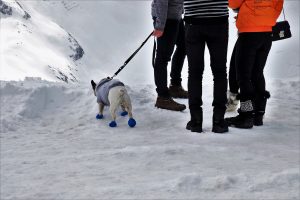

How to Protect Your Dog’s Paws in Cold Weather
No matter who you are, winter can get the best of you. The same goes for your pup too!
Winter brings cold temperatures and dry air. The combination can really cause havoc on your skin if you don’t take precautions. You must help your dog out too, otherwise, they’ll suffer the same fate.
Today we look at how to protect your dog’s paws in cold weather.
How to Protect Your Dog’s Paws
The cold, dry air that moves in for winter can be very bothersome for people and pets alike. Below are some suggestions for how to help your dog deal with the weather.
Booties
You’ve probably seen funny videos online of the silly walk some dogs or cats can do when they wear booties. Wearing “gloves” is unnatural to dogs. But once they get used to it, it really can be one of the best ways to protect their paws from the elements.
What your dog needs is a barrier from the snow and ice. Most booties offer full coverage to protect your dog’s paws and keep them warm. Many booties are even styled after shoes and offer a traction-enhancing sole. When considering how to protect your dog’s paws in cold weather, booties usually offer the most protection.
Balms and Lotions
Another popular choice for paw protection are salves.
There are many kinds of lotions or balms you can find at your local pet store to help protect your dog’s paws. They usually create a protective barrier by having you massage the lotion into your dog’s paw.
While there are a wide variety of these paw balms available for purchase, you can even read up on DIY recipes. They are easy to make and are a natural way to help keep your dog’s paws soft over the winter. The barrier that the balm creates protects your dog from the salt that many people use for de-icing.
Use a Towel
After going outside for your walk, use a towel to clean and dry your dog’s paws. This will help clean off any debris that may have accumulated on your dog’s paws while they were walking through the snow.
If you find there is some grime or even ice that has accumulated on their paws, you can use some lukewarm water to clean their paws. Just make sure the water really is lukewarm. If the water is too hot, you can burn your dog’s feet. They are especially sensitive after being in the cold for so long. And if you do use water, be sure to wipe their paws and fur down when you are done cleaning them. Speaking of which…
Grooming
We all know that dogs need to be brushed when they are going through their shedding period. You should also be brushing them during the winter too. The rubbing of the brush will help stimulate blood flow to your dog’s skin. This will keep their coat looking beautiful, but it will also keep their skin healthy during the winter.
If your dog has fur between their toes and the pads of their feet, you may consider keeping that hair trimmed over the winter. It’s so easy for ice and dirt to cling to that hair and form ice chunks that will make it difficult or painful to walk.
Minimize Time Outside
While many dogs enjoy romping around in the snow, it’s not for all dogs. Dogs that do not have warm coats or are small simply cannot be left outside for very long. If this is your dog, you should always supervise their time outside and keep visits outside very short.
If your dog likes to be outside despite the weather, you can give them more frequent trips for shorter periods of time.
De-Icers
This isn’t as much of a way to protect your dog as much as it is a reminder. Many people use salt to help melt ice when temperatures drop. Salt works well to melt ice, but it also can cause dogs a lot of pain. Not only do the salt crystals hurt to walk on, but the chemicals used can cause injury to your dog. Your dog will also be bringing those chemicals into your home!
Be sure to clean your dog’s paws if you let them go out barefoot. If they do wear footwear, be sure you leave it at the doorway.
These tips on how to protect your dog’s paws











